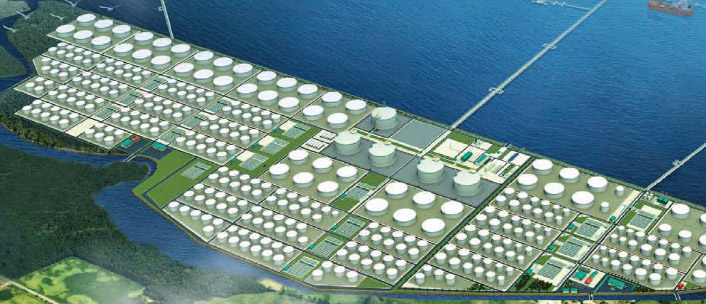
Deep and complex
Case study is published by the trade journal hemmingfire.com
Published: 04th December, 201
A case study in the fire protection technology:
A major new deepwater petroleum terminal in Malaysia, which also marks Southeast Asia’s first independent land based storage facility, is protected with the latest in fire detection technology.
Phase One of three stages of works at the Independent Deepwater Petroleum Terminal in Pengerang, Johor, is now complete on the 200-acre reclaimed plot which is located along major international shipping routes at the southeastern tip of the Malaysian Peninsula. In addition to its convenient location to international sea lanes, Pengerang’s sheltered harbour and deep water makes it an ideal location to serve as an oil, gas and petrochemical hub.
The Independent Deepwater Petroleum Terminal is owned by PITSB – a joint venture among Dialog Group Berhad, Royal Vopak and State Secretary, Johor (Incorporated). The completion of Phase One was marked by a visit by the Prime Minister of Malaysia, Datuk Seri Najib Razak, who attended the official site opening in June 2014. The terminal is an important economic development for Pengerang, creating thousands of new jobs, in additional to attracting other investors to the area.
Once fully completed, the terminal will have the capacity to store, blend and distribute five million cubic meters (cbm), or approximately 36.5 million barrels, of crude oil and refined petroleum products. The completion of Phase One already facilitates the storage capacity of approximately 1.3 million cbm of oil products in 61 storage tanks, as well as a 24-metre-deep jetty facility capable of handling very large crude carriers.
The Apollo fire detection system was specified and installed by fire detection specialist Sentrix Technology, which was selected by construction specialist Dialog E & C Sdn Bhd, to procure, install, test, and maintain the terminal’s fire protection and toxic gas detection systems.
The Independent Deepwater Petroleum Terminal fire detection system is based around nine NSC Sicherheitstechnik addressable alarm panels,. with the network system linked by a fibre optic and copper wire system. Each panel has a different numbers of zones depending on which building it protects in the terminal. The main devices used in the system are from Apollo’s Discovery range, comprising 61 smoke detectors, 24 heat detectors, 33 Manual Call Points and nearly 200 Mini Switch Monitors to interface with other equipment.
Due to the potentially volatile environment at the terminal, a number of additional detectors were installed. This included the specification of 20 stainless-steel-cased Apollo explosion IR3 Flame Detectors and Open Path Gas Detectors to protect the large open pit sump and jetty areas, in additional to linear heat detectors for all internal floating roof tanks. Heavy-duty weather proof and explosion proof sounders and Xenon beacons were also installed at the bund wall of 61 storage tanks.
The large site area at the Independent Deepwater Petroleum Terminal also meant that special consideration was given to the sound alarms at the site. Any triggered alarm will sound alarm bells as well as a total of eight air horn sounders which have been strategically installed for large open area notification in the terminal and jetty areas.

The Independent Deepwater Petroleum Terminal in Malaysia
An additional factor for consideration in the design of the terminal fire detection system was the marine nature of the site, and the potential causes of false alarms on site. These considerations included the high salinity of the coastal location, high ambient temperatures on site and the lightning-prone equatorial climate.
As a result of the hazards posed by the nature of the terminal, the fire detection system also had to comply with a number of industry regulations, including those of the Jabatan Penyelamat & Bomba Malaysia local authority, American National Fire Protection Association (NFPA) Codes, Malaysian Standard (MS) and the Uniform Building By-Laws (UBBL) 1984.
Speaking about the installation, Chong Yin Keong, General Manager at Sentrix Technology, said: ‘This was a complex project with very many factors which needed consideration when designing the system. Not only is the site very large and varied in terms of differing marine jetty and land-based storage areas, but the potential risks posed by the large amount of crude oil and refined petroleum products stored on site meant that the design needed to be robust enough to cope with this demanding environment.
‘When specifying the system we were confident that Apollo was the right choice for this application, and our confidence has been rewarded following this successful phase one installation.’
Concluding, Simon Flavell, Business Development Manager - Marine & Offshore at Apollo Fire Detectors, said: ‘Our Discovery range of high-specification intelligent fire detectors was the ideal choice for the Independent Deepwater Petroleum Terminal, as they have been specifically developed for installations where adaptability to changing conditions and protection against unwanted alarms are of paramount importance.
‘The Discovery range allows for the provision of different levels of sensitivity depending on the needs of the space to be protected. This is possible because Apollo Discovery fire detectors feature five selectable sensitivity bands that make them particularly adaptable to a wide range of environmental conditions.
‘At Apollo we’re really proud to have been involved in such a landmark project for both Pengerang and Malaysia as a whole, and look forward to our continuing involvement as the terminal evolves under phases two and three.’
Download the original article >
Website of the trade magazine >


